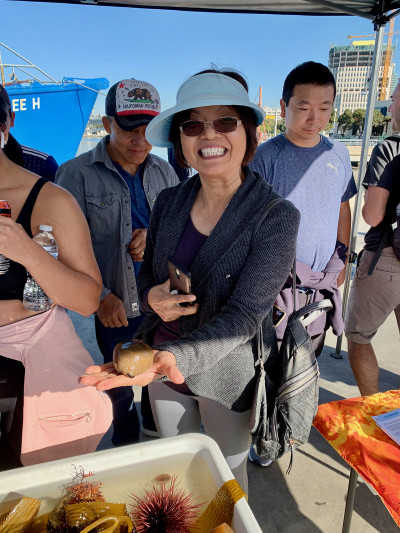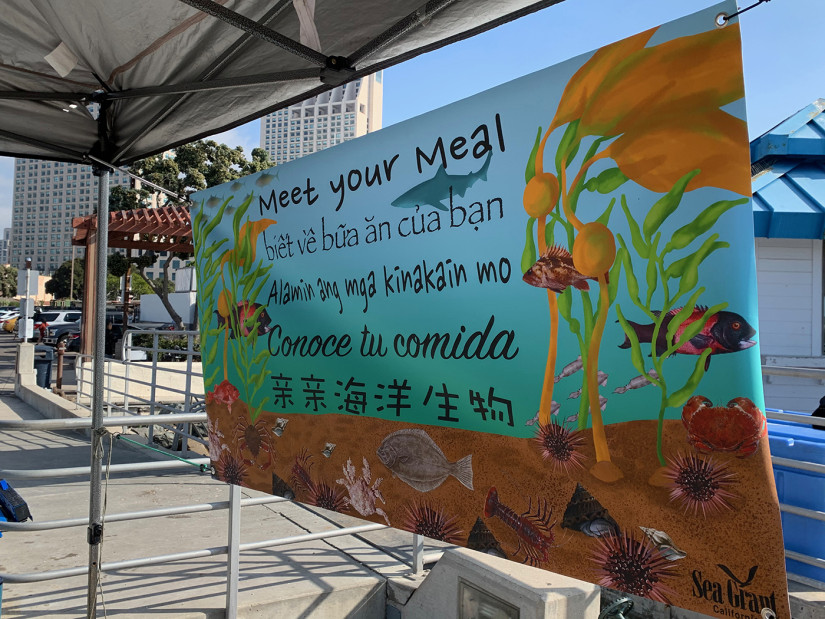Five years ago, the Tuna Harbor Dockside Market, often dubbed “the market” by locals, was established on a pier in San Diego Bay overlooking one of the city’s last remaining working fishing harbors. At this open-air fishermen’s market, visitors can buy fresh, sustainably harvested fish, venture to try uncommon foods like box crab and fresh sea urchin, chat with the local fishermen and their families, and learn about the beautiful sea life of San Diego displayed at interactive touch tables, all while strolling along the harborfront pier. Today, the market is a popular spot for seafood lovers in the San Diego community—every Saturday morning a queue of eager visitors forms, patiently waiting for the market to open so they can have the freshest pick.
As a seafood lover myself, I was curious to know who the market is reaching and how, so that I can help inform efforts to increase access to fresh, local seafood. So as part of my bachelor’s thesis for University of California, San Diego (UCSD), I set out to learn who the seafood lovers of San Diego are, under the guidance of California Sea Grant Extension Specialist Theresa Talley. From November 2019 through March 2020, I ran interactive touch tables at the market, asked visitors various questions about their background and their interest in seafood , and learned a few interesting things.
First of all, people were willing to travel quite a distance to the market! Within San Diego County, visitors traveled an average of 21 miles one way for fresh seafood, with most visitors coming from around the city of San Diego, Chula Vista, Carmel Valley, and Rancho Peñasquitos. Tourists were noticing the market too—although fewer tourists purchased seafood, many of them enjoyed walking through the market, getting to know the fishermen, and taking pictures.

Just over half of the visitors to the market identified as Asian, a quarter were White, and a quarter identified as biracial, Latinx, Black, or Pacific Islander. Of those who made purchases, I found that different racial-ethnic groups had unique preferences for seafood, and their preferences changed whether they were shopping at the market or other retail stores, like supermarkets and wholesale markets.
Asian-identifying customers had a broader seafood pallet than other groups, preferring non-mainstream seafoods, such as crab, red sea urchin, and snails, in addition to mainstream types (such as tuna). At the market, whole fish was at the top of everyone’s list--it was similarly or more popular than fileted fish across all groups. However, when these same people shopped at other retail markets for seafood, preferences changed. Fileted fish and processed seafoods became the most popular choices. Even Asian customers were more likely to choose fileted fish and less likely to choose snail, sea urchin and crab, although their preference for whole fish did not waiver.
These trends, coupled with comments from the visitors, revealed motivations underlying these choices. The freshness and uniqueness of the seafood at the market, and the experience of the market itself, were factors that motivated visitors to come buy from local fishermen; after all, there aren’t many other places where one can buy a whole tuna fish, local shark, or live sea urchins right from the people who caught them. In contrast, the convenience of a grocery store in your own neighborhood that is open daily, the ease of having prepared products, and the often lower prices of imported seafood, were all drivers of retail market seafood purchases.
From this experience, it became clear to me that the market supports a vibrant, diverse community of seafood lovers in San Diego. Its reach is distributed throughout the area, and serves many cultures and racial-ethnic backgrounds. As I interacted with fishermen, tourists, and regular visitors to the market, I came to see not just the economic value of having fresh, local seafood, but also the social value of having such a space accessible to the public. Not only does the market connect San Diegans and tourists with the local seafood and sealife, it is also a space for building long-term relationships between San Diego’s fishing community, seafood lovers, and businesses. It is a space where we can have discussions about the unique relationship among ourselves, our cultures, and seafood.
I see direct marking venues like the market as a platform where we can work towards the goal of strengthening our seafood systems, and create inclusive access to high quality, local sustainable seafood, as the current Fish to Families program in San Diego demonstrates. All in all, my hope is that what I’ve learned can provide some insight into the beautiful diversity of San Diego’s people and sealife, and show the importance of and opportunities for connecting and building meaningful relationships through seafood. Although the market is but one aspect of the complex world of seafood, its economic, educational, and social impacts show the potential that such spaces have to shape better futures for our communities. By creating more outlets like this one, such as those throughout the state and the one proposed for Oceanside Harbor, we can look forward to a future where we are more connected to one another, our food, and the environment we live in.
See my full report here.




